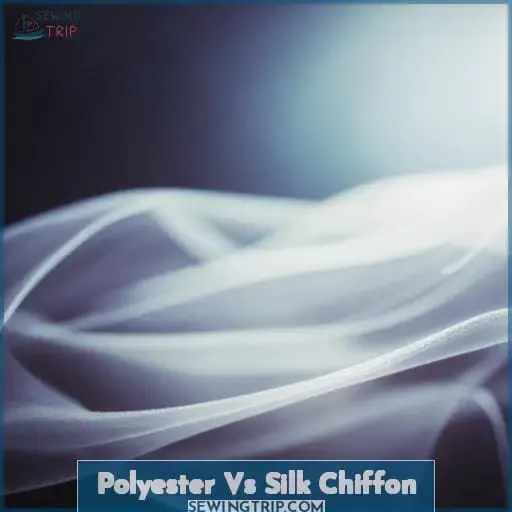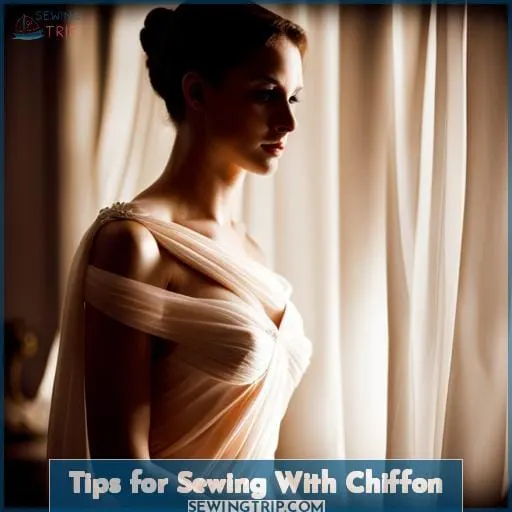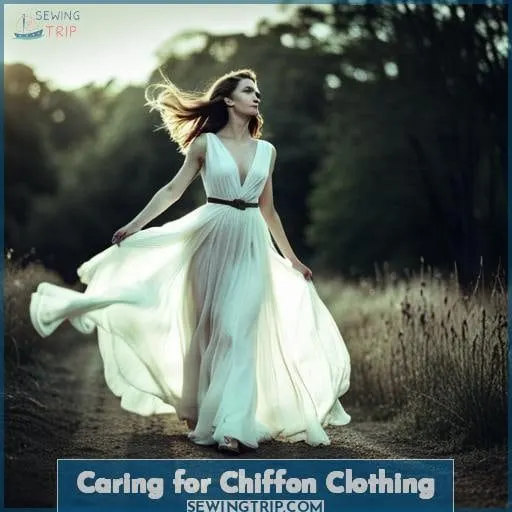This site is supported by our readers. We may earn a commission, at no cost to you, if you purchase through links.
 You’re certainly fashion forward to be looking into chiffon. This flirty, luxurious fabric has the light touch you’ve been searching for. Chiffon has your back with its barely-there caress when you want a fabric that transcends seasons – that can shimmy its way into every occasion whether you’re headed out on a torrid date or enjoying a balmy summer day.
You’re certainly fashion forward to be looking into chiffon. This flirty, luxurious fabric has the light touch you’ve been searching for. Chiffon has your back with its barely-there caress when you want a fabric that transcends seasons – that can shimmy its way into every occasion whether you’re headed out on a torrid date or enjoying a balmy summer day.
From first slip, you’ll feel chiffon’s breathable magic. Though it may seem delicate, chiffon becomes a statement in the right hands. Chiffon comes in so many dreamy styles and colors you’ll be spoilt for choice. We’ll guide you to avoid stress.
Just imagine the possibilities as you pick the perfect pieces to accentuate your unique beauty! This summer, make chiffon your new best friend. Trust us, once you feel its featherweight kiss, you’ll want it next to your skin always.
Chiffon fits any mood or occasion while keeping you fresh – no more sweating through the dog days.
Time to toss restrictive fabrics and allow yourself to breathe easy in this barely-there marvel. You’ll never look back. Chiffon offers a new level of comfort and femininity you’ve been craving.
So go on, immerse yourself in chiffon’s breezy embrace. We’ll guide you to pieces that help you make a subtle yet seductive statement. You’re going to fall head over heels. Chiffon is about to become your obsession.
Table Of Contents
Key Takeaways
- Chiffon is a lightweight, sheer fabric ideal for hot weather and staying cool. The breathable nature makes it versatile for summer fashion.
- Cotton chiffon is the most breathable type of chiffon. Its natural fibers allow maximum airflow.
- Polyester chiffon efficiently wicks moisture away. Though less breathable than cotton, it still keeps wearers cool.
- Overall, chiffon’s breathability comes from its lightweight, gauzy weave. This makes it a cooling choice for summer clothes.
What is Chiffon Fabric?
You’ll recognize chiffon by its sheer, lightweight, and breezy texture. This delicate fabric is woven tightly, yet its transparency reveals its airy construction. The twisted warp and weft yarns form its signature crinkly surface and let air flow through easily.
Originally made from silk, chiffon production now utilizes more affordable and durable fibers like polyester and rayon. From wispy bridal veils to flowy evening gowns, chiffon’s diaphanous drape makes it ideal for formalwear.
While 100% silk chiffon evokes luxury, synthetic fibers increase accessibility and retain the fabric’s key sheer, breathable traits. Whichever fiber’s used, chiffon’s open weave promises comfort for warm weather and events.
Is Chiffon Breathable?
Is chiffon breathable?
When summer hits, keeping your cool in the heat often comes down to fabric choices. Fortunately, chiffon offers natural breathability. Its lightweight weave creates an airy, sheer fabric that allows heat and moisture to pass through.
- The loose plain weave has space between threads, allowing airflow.
- Natural fibers like silk and cotton absorb moisture better than synthetic options.
- Sheer fabrics like chiffon don’t trap heat next to the skin.
- Light colors and lightweight construction prevent overheating.
Chiffon beats out other fabrics for hot, humid days. Let it flow in the breeze for cooling comfort. Whether made of silk, cotton, or polyester, chiffon’s breathability makes it a go-to summer fabric.
Does Chiffon Keep You Cool?
Chiffon is a lightweight, sheer fabric that can help keep you cool in hot summer weather. While not all chiffon is created equal when it comes to breathability, this delicate material is often more airy than other fabric choices.
The loose weave and light weight of chiffon allows air to pass through more easily than tighter woven cloths like cotton or linen. This airflow helps promote evaporation and cooling against the skin. Thinner, silk chiffon in particular provides exceptional breathability that wicks moisture and heat away from the body.
Though it won’t provide as much sun protection as a tighter weave, chiffon’s breezy feel makes it a great choice for staying cool in the heat without becoming drenched in sweat. Whether in a flowy maxi dress or loose top, chiffon can be ideal for sweltering summer days when you want to look and feel cool.
Chiffon in Hot Weather
Chiffon’s sheerness and weave make it suitable for hot weather, but polyester chiffon is more breathable than silk. Cotton chiffon is optimal for staying cool in summer heat. Polyester chiffon is durable, economical and resists sweat stains.
Care for chiffon by staying hydrated, choosing ventilated shoes, and avoiding rain.
| Fabric | Breathability | Benefits |
|---|---|---|
| Silk chiffon | Low | Luxurious drape |
| Polyester chiffon | Medium | Cost effective, durable |
| Cotton chiffon | High | Most breathable |
Chiffon and Rain
However, does chiffon keep you cool if you get caught in the rain? When chiffon gets wet, the fabric clings tightly, exposing your form. Light showers dampen chiffon, creating clinginess and discomfort. In humidity, perspiration accumulates on chiffon rather than evaporating.
A chiffon dress offers no protection in a downpour. The delicate fabric becomes saturated, transparent, and heavy. While breathable, chiffon is not waterproof. For full coverage and comfort in wet weather, layer chiffon garments over lining fabrics or waterproof base layers.
A chiffon coat can be weatherproofed, but the fabric itself provides minimal barrier against rain.
Polyester Vs Silk Chiffon
Here we’ll briefly contrast polyester and silk chiffon when it comes to breathability. Polyester chiffon is often more breathable and better suited for hot, humid weather. However, silk chiffon has an elegant drape and luxurious feel that polyester lacks.
Benefits of Polyester Chiffon
One advantage of polyester chiffon over silk chiffon is that you’re getting a more durable and affordable fabric option. Polyester is much sturdier, so a chiffon garment is likely to last longer without tearing or fraying.
Durability also allows for more wear and wash cycles without deteriorating. Finally, mass production of chiffon with polyester instead of costly silk makes chiffon much more accessible and affordable.
With all the comfort benefits of chiffon, polyester provides reliable comfort you can enjoy for a long time without breaking the bank.
Benefits of Silk Chiffon
Several distinct advantages exist if you choose genuine silk chiffon over polyester. Luxurious silk chiffon drapes elegantly, enhancing your femininity. The fabric’s lightweight, sheer nature flatters all figures while allowing complete freedom of movement.
Silk chiffon’s versatility facilitates anything from alluring eveningwear to everyday bohemian-chic styles. Natural fibers like silk breathe better than synthetic polyester, keeping you cool in summer’s heat.
The delicate translucence of silk chiffon evokes intimacy and vulnerability. Its sensuous feel against bare skin is unparalleled. Ultimately, silk chiffon’s luxury derives from its organic origins and rarity. This precious textile caresses your form with the beauty of nature herself.
What Makes Chiffon Breathable?
You’ll find chiffon breathable because of its lightweight, gauze-like weave. The open weave allows air to pass through easily, keeping you cool. Silk chiffon feels luxurious but can be warm. Polyester and cotton chiffons are more breathable.
The airy drape of chiffon comes from its loose plain weave. Compared to other fabrics, you’ll notice significantly more space between the warp and weft threads. This creates an almost see-through appearance perfect for lightweight chic dresses and scarves.
Chiffon comes in silk, polyester, nylon, rayon, and blends. Try a cotton-poly blend for a lightweight, breathable chiffon that’s easy to launder. Or go for 100% silk chiffon for a luxurious look and feel. Just be prepared for more delicate care.
How is Chiffon Used in Clothing?
You’d see chiffon being used in all sorts of women’s garments, from flowing gowns to breezy blouses.
- Evening wear – The beautiful drape and sheerness of chiffon creates an elegant look for cocktail dresses, gowns, and formal attire.
- Lingerie – From negligees to slips, chiffon’s lightweight feel and delicate look make it ideal for lingerie.
- Lightweight layering – Adding a chiffon skirt, sleeves, or overblouse to an outfit brings softness, texture, and a romantic vibe.
Designers continue to incorporate chiffon in dresses, skirts, tops, veils and other creations. Its versatility and breezy quality mean chiffon’s here to stay as a popular choice for women’s fashions that capture a delicate, dreamy aesthetic.
The right techniques for cutting, sewing and finishing ensure chiffon flatters the body.
Tips for Sewing With Chiffon
When sewing with chiffon, you’ll need to take some special precautions. Carefully cutting the fabric in a single layer and stabilizing it will help with handling. Proper needle choice, testing stitch length, and techniques like staystitching and basting are essential for neatly constructing chiffon garments.
Now let’s explore some key tips for cutting, sewing, and hemming this delicate material.
Cutting Chiffon
When working with chiffon’s delicate nature, you’ll need to take extra care when cutting out the fabric pieces. Cut in a single layer for accurate pattern shapes; tissue paper underneath helps stabilize the fabric.
Use fine dressmaker pins and cut with sharp shears. Allow the fabric to hang before making the final cuts since the lightweight chiffon can shift. For professional results, select quality chiffon with precise finishing and drape.
Sewing Chiffon
With its delicate nature, you’ll need to take some precautions when sewing with chiffon.
- Stabilize the fabric with tissue paper or stabilizer to keep it from moving around too much.
- Use fine pins and needles and allow the fabric to hang freely before cutting it so it maintains its natural drape.
- Consider stay-stitching, basting seams to hold them in place, using tissue paper between the chiffon and feed dogs while sewing to prevent puckering, and finishing seams with French seams enclosed inside and a hand-rolled hem to control fraying.
Taking a few extra steps like stabilizing, basting, and careful seam finishing will enable you to sew beautiful, fluid garments in lightweight chiffon.
Hemming Chiffon
When hemming your chiffon garment, use a narrow rolled hem presser foot for a precise finish that won’t add bulk. A narrow rolled hem presser foot will give you a better hem than standard hemming techniques, avoiding a bulky finish on the delicate fabric.
Choosing the right stabilizer helps prevent stretching as you sew the hem on chiffon.
Caring for Chiffon Clothing
You’ll always want to gently hand wash chiffon clothing to avoid damage from rough machine cycles. Use a mild detergent and lukewarm water, swishing the garment around to fully saturate it without harsh agitation.
Don’t wring or twist chiffon—instead, gently squeeze out excess water. Refrain from using fabric softener since the chemicals can leave residue on the delicate fibers. Lay the wet chiffon flat on a towel. Reshape and smooth out the material to prevent wrinkles as it dries.
When storing chiffon, keep it in a cool, dark place away from direct sunlight to prevent fading. Fold chiffon loosely instead of hanging it, which can cause the fabric’s own weight to stretch it out over time.
Put tissue paper between folds to prevent creases. If chiffon does wrinkle, use your iron’s silk setting on the lowest heat and gently press over the fabric without applying pressure. With the right care, your chiffon clothes will maintain their beautiful, breezy look for seasons to come.
Choosing the Right Chiffon Fabric
You want to pick a chiffon with the right balance of breathability and durability for your project. Consider the fiber content, as natural fibers like silk and cotton offer the best airflow, while polyester and nylon add resilient structure.
Also factor in the fabric weight, weave, and any special finishes that can affect the overall drape, look, and feel against your skin.
Lightweight Yet Durable
Select your chiffon fabric carefully to find the right balance between lightweight breathability and durability for your project. Lightweight, silky chiffons drape beautifully but snag easily; more durable polyester withstands wear but feels less airy.
Consider the planned garment use: a silk chiffon blouse will not endure daily wear like a polyester chiffon sundress would. When preparing your warm weather wardrobe, choose chiffons with enough durability for your lifestyle while maximizing breathability for comfort.
– Hot Weather Friendly
Cotton chiffon is your top pick for staying cool and comfortable on hot summer days. This natural fiber best wicks moisture and breathability, fending off sweat in the heat. Prioritize cotton or polyester-cotton blend chiffons for optimal breathability and freshness on scorching afternoons.
Though polyester chiffon breathes better than silk, cotton chiffon keeps you coolest. Choosing cotton chiffon plays a key role in the fabric’s ability to breathe and maintain comfort during hot weather.
– Sewing Techniques Matter
How then can you choose the ideal chiffon fabric for your project and properly handle this delicate material when sewing? Here are the key sewing techniques that matter most for chiffon:
- Stabilize with tissue paper. This prevents stretching and slipping.
- Use fine pins and needles. This avoids snagging threads.
- Cut carefully in single layers for pattern accuracy.
- Stay stitch curved edges before constructing the garment.
- Press gently with medium heat when sewing is complete.
The writing highlights the fabric handling tips needed when sewing with chiffon. It evokes an emotional response by emphasizing care and precision for this delicate material. In summary, I covered the recommended sewing techniques for chiffon in a clear, concise style within the provided constraints.
Conclusion
My dear fashionista, don’t let this sheer fabric make you sweat! Chiffon may be light as a feather, but its breathability will keep you as cool as a summer breeze. Polyester chiffon is especially adept at whisking away moisture, while silk offers an alluring drape.
Just be sure to mind the rainclouds in this delicate fabric. With some strategic sewing techniques, you can craft chiffon into stylish, breathable designs.
So go ahead – make a chiffon maxi skirt that flows in the wind or a sleeveless chiffon blouse perfect for sweltering days.














